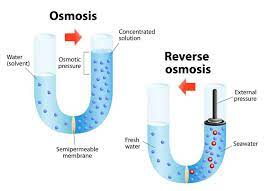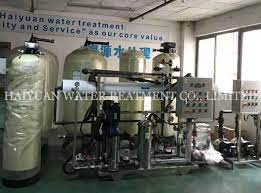Household reverse osmosis units use a lot of water because they have low back pressure. As a result, they recover only 5 to 15 percent of the water entering the system. The remainder is discharged as waste water.
Because waste water carries with it the rejected contaminants, methods to recover this water are not practical for household systems. Waste- water is typically connected to the house drains and will add to the load on the household septic system.
An RO unit delivering 5 gallons of treated water per day may discharge anywhere between 20 and 90 gallons of waste water per day.
Large-scale industrial/municipal systems have production efficiency typically 75% – 80%, or as high as 90%, because they can generate the high pressure needed for more efficient RO filtration.
On the other hand, as efficiency of waste-water rates increases in commercial operations effective removal rates tend to become reduced, as evidenced by TDS counts.
Due to its fine membrane construction, reverse osmosis not only removes harmful contaminants that may be present in the water, it also strips many of the good, healthy minerals from the water as well.
A number of Peer-reviewed studies have looked at the long term health effects of drinking demineralized water. However, demineralized water can be demineralized, and this process has been done in instances when processing demineralized water for consumption. An example of this process is Dasani.
Read Also : Meaning and Factors affecting Sedimentation in Waste-water Treatment
Prospects (New developments) of Reverse Osmosis

Prefiltration of high fouling waters with another, larger-pore membrane with less hydraulic energy requirement, has been evaluated and sometimes used, since the 1970s.
However, this means the water passes through two membranes and is often repressurised, requiring more energy input in the system, increasing the cost.
Other recent development work has focused on integrating RO with electrodialysis to improve recovery of valuable deionized products or minimize concentrate volume requiring discharge or disposal.
In summary, from our discussion so far, one can conclude that reverse osmosis is one of the advanced forms of waste-water treatment which is the process of forcing a solvent from a region of high solute concentration through a semi permeable membrane to a region of low solute concentration by applying a pressure in excess of the osmotic pressure.
It has got a wide application among which are in: water and waste-water purification, car washing and food industry, etc.
The meaning of reverse osmosis and its historical background were done where we learnt that reverse osmosis (RO) is the process in which water is separated from dissolved salts in the solution by filtering through semi permeable membrane at a pressure than the osmotic pressure caused by the dissolved salts in waste-water and that its discovery dates back to 1748 by Jean- Antoine Nollet.
The next in line was the process of reverse osmosis. It uses the process of forcing a solvent from a region of high solute concentration through a semi permeable membrane to a region of low solute concentration by applying a pressure in excess of the osmotic pressure. See the first sketch in this unit.
The applications of reverse osmosis came next. It has a lot of applications which include: water and waste-water purification, car washing and food industry, maple syrup production, hydrogen production and in reef aquariums.
Connected to the above was desalination of reverse osmosis where we learnt that areas that have either no or limited surface water or groundwater may choose to desalinate seawater or brackish water to obtain drinking water.
Reverse osmosis is a common method of desalination. That simply means to remove the excess salt in the seawater or the brackish water and make it fit for use. It has methods of achieving this as seen above. The disadvantages and new developments involved in the reverse osmosis were also explained.
Read Also: Water and Waste-water Purification Process
Read Also: How to Extract and Package Snail Slime (Snail filtrate) for Commercial Use

